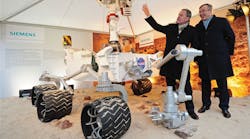NASA only had one shot at landing its $1.8 billion rover on Mars in 2012. There were no dry runs, no beta tests, no Earthly place to practice—its engineers had to get everything perfect on their first and only flight.
Their success at that mission is regarded as the pinnacle triumph of our space-age technologies, one that was supposed to herald a new age of interplanetary exploration.
But it also inspired something interesting down here on Earth.
To stick its Martian landing, NASA used some sophisticated PLM software from Siemens to simulate every twist and turn of its 354-million-mile journey and every nerve-racking second of its perilous 70,000 mph blind descent. It was a demonstration of the full power and potential that simulation software like this has developed over the last decade.
In the 18 months since Curiosity touched down, that technology has trickled down into R&D labs across the manufacturing industry and has quietly begun changing the way we make just about everything.
Digitizing the Iron Age
On the face of it, there’s not much about Ohio’s Wellsville Foundry that reminds one much of space travel or Martian expeditions.
“We make products in a process that Jesus would recognize if he walked into the foundry,” says Wellsville President C.H. Gilmore. “The basic metalcasting process hasn’t actually changed much for 2,000 years.”
See Also: Manufacturing Innovation & Product Development Strategy
Behind the scenes, however, Gilmore’s engineers are running a sophisticated suite of high-grade simulation software that would seem right at home in a Martian mission. It’s capable of simulating every movement of a pour: every contact between molten metal and sand mold, every chemical reaction, every slight degree shift or shrinkage defect.
Just like NASA’s system helped chart the path to Mars, Gilmore’s system—a foundry-specific suite by MAGMA—provides insight into the invisible, unobservable parts of the operation. As Gilmore puts it, “It’s as close to being in the mold as you can get without being burned up.”
And that has totally upended Wellsville’s business.
The New Foundry
Traditionally, foundries like Wellsville would spend months trying to work out every last defect from a new part. That meant designing and forming molds to cast prototypes, which were then cut apart for visual inspection—an expensive, time-consuming process to say the least. But now that work is done on the computer screen instead.
For some jobs, Gilmore says, this has reduced scrap and defects from 50% to under 5% for a new product. What’s more, the finished parts he creates are now certifiable through X-ray, radiation and ultrasonic testing—pretty much anything that regulators can throw at them. Combined, that means, with only 20 employees on staff, Gilmore has suddenly found himself able to compete on low-quantity jobs with every foundry in the world. And that signals a pretty significant shift.
| See how Siemens’ software is helping to standardize efficiency across Ford’s global platform at iw.com/googling-the-future. |
“The industry has come a long way,” Gilmore says. “There are a lot fewer foundries today than there were when I bought mine in 1986. Those of us that are still around have a choice: We can either move forward on the leading edge or be left behind.”



